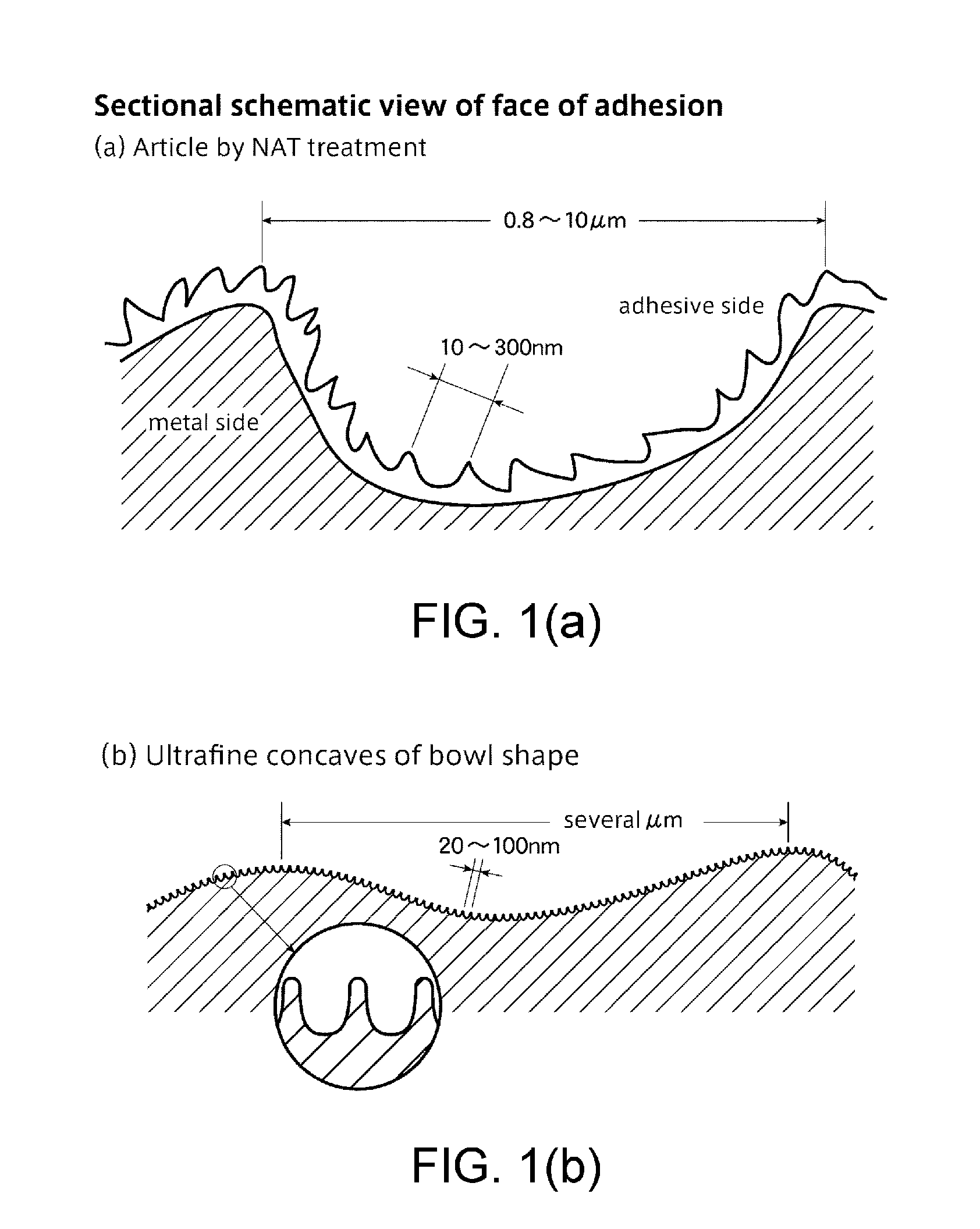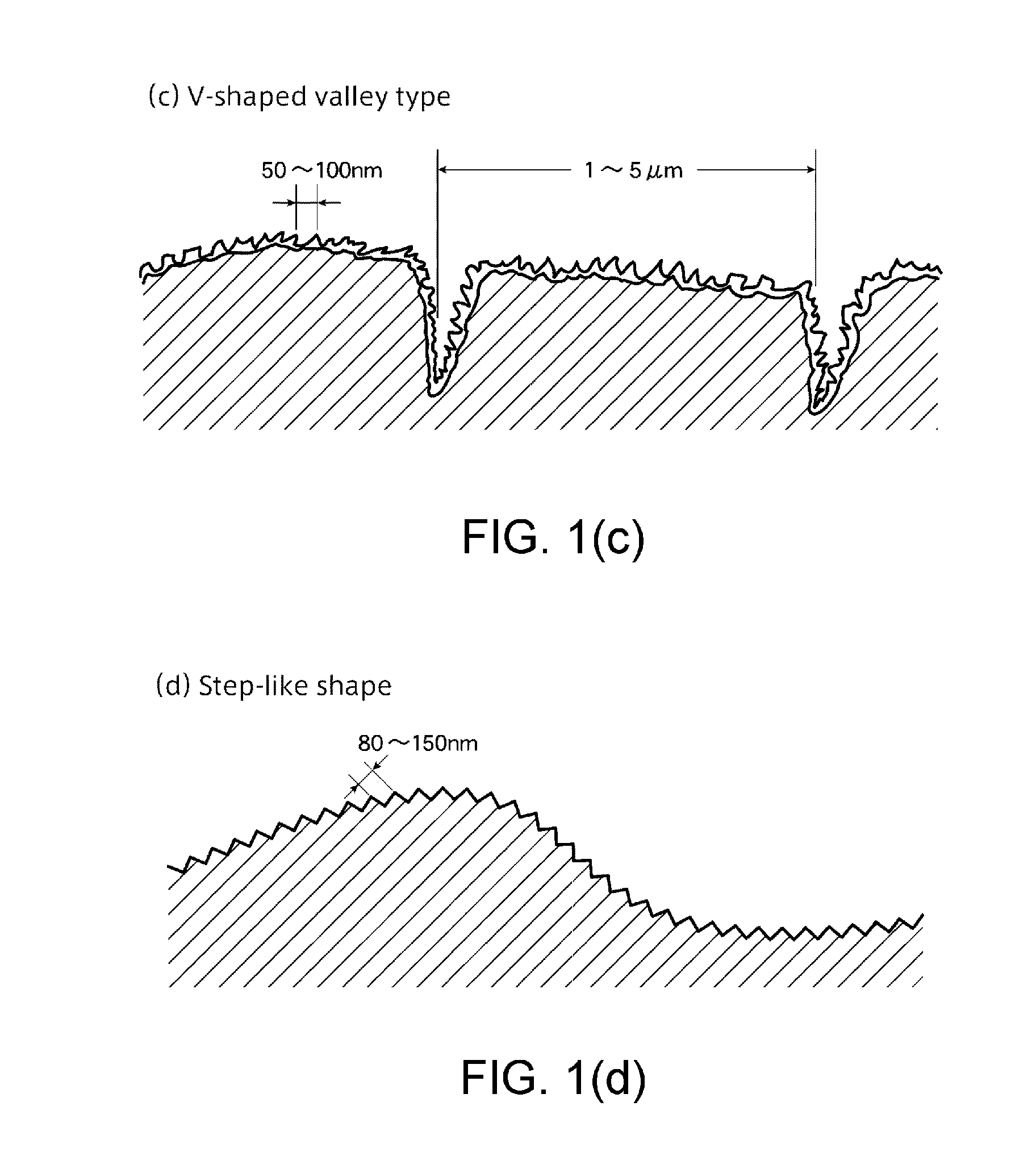Method for producing metal containing composite and metal containing composite formed by adhesion
a metal containing composite and metal containing composite technology, which is applied in the direction of film/foil adhesives, adhesive types, layered products, etc., can solve the problem that the connection of bolts and nuts cannot be used to connect cfrps with one another, and the number of working steps required for forming through holes is beyond supposition, so as to achieve high adhesion strength
- Summary
- Abstract
- Description
- Claims
- Application Information
AI Technical Summary
Benefits of technology
Problems solved by technology
Method used
Image
Examples
experiment example 1
NAT Treatment of Al-Alloy
[0187]Sheet stocks of Al-alloy A7075 having a thickness of 3 mm were acquired and machined to form a plurality of small pieces with a dimension of 45 mm×15 mm×3 mm. Further, a plurality of small pieces with a dimension of 100 mm×25 mm×3 mm were formed by machining from the same Al-alloy sheet stocks. An aqueous solution containing degreaser for aluminum “NE-6” (made by Meltex co. Ltd., main company in Tobkyo, Japan) by 10% was made ready to be at 60° C. in a tank, in which the above alloy pieces were immersed for 5 minutes, and after then the pieces were rinsed with tap water (Ota city, Gumma prefecture, Japan). Next, an aqueous solution of hydrochloric acid having a concentration of 1% was made ready to be at 40° C. in another tank, in which the pieces were immersed for 1 minute and after then the pieces were rinsed with water. Next, an aqueous solution of caustic soda having a concentration of 1.5% was made ready to be at 40° C. in still another tank, in w...
experiment example 2
New NAT Treatment of Al-Alloy
[0189]Sheet stocks of Al-alloy A7075 having a thickness of 3 mm were acquired and machined to form a plurality of small pieces with a dimension of 45 mm×15 mm×3 mm. Further, a plurality of small pieces with a dimension of 100 mm×25 mm×3 mm were formed by machining from the same Al-alloy sheet stocks. An aqueous solution containing degreaser for aluminum “NE-6” by 10% was made ready to be at 60° C. in a tank, in which the above alloy pieces were immersed for 5 minutes, and after then the pieces were rinsed with tap water (Ota city, Gumma prefecture, Japan). Next, an aqueous solution of hydrochloric acid having a concentration of 1% was made ready to be at 40° C. in another tank, in which the pieces were immersed for 1 minute and after then the pieces were rinsed with water. Next, an aqueous solution of caustic soda having a concentration of 1.5% was made ready to be at 40° C., in which the alloy pieces were immersed for 4 minutes and after then rinsed wit...
experiment example 3
NAT Treatment of Stainless Steel (Referential Example)
[0191]Sheet stocks of stainless steel SUS304 having a thickness of 3 mm were acquired and machined to form a plurality of small pieces with a dimension of 45 mm×15 mm×3 mm. Further, a plurality of small pieces with a dimension of 100 mm×25 mm×3 mm were formed by machining from the same stainless sheet stocks. An aqueous solution containing degreaser for aluminum “NE-6” (made by Meltex co. Ltd., main company in Tokyo, Japan) by 10% was made ready to be at 60° C. in a tank, in which the above steel pieces were immersed for 5 minutes, and after then the pieces were rinsed with tap water (Ota city, Gumma prefecture, Japan). Next, an aqueous solution of caustic soda having a concentration of 1.5% was made ready to be at 40° C. in another tank, in which the steel pieces were immersed for 1 minute and after then rinsed with tap water. Next, an aqueous solution of sulfuric acid having a concentration of 5% was made ready to be at 65° C.,...
PUM
| Property | Measurement | Unit |
|---|---|---|
| diameter | aaaaa | aaaaa |
| temperature | aaaaa | aaaaa |
| height | aaaaa | aaaaa |
Abstract
Description
Claims
Application Information
 Login to View More
Login to View More - R&D
- Intellectual Property
- Life Sciences
- Materials
- Tech Scout
- Unparalleled Data Quality
- Higher Quality Content
- 60% Fewer Hallucinations
Browse by: Latest US Patents, China's latest patents, Technical Efficacy Thesaurus, Application Domain, Technology Topic, Popular Technical Reports.
© 2025 PatSnap. All rights reserved.Legal|Privacy policy|Modern Slavery Act Transparency Statement|Sitemap|About US| Contact US: help@patsnap.com



